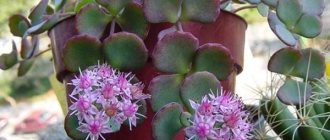Indoor flowers not only decorate a person’s home: they are a kind of light apartment and wonderful decor. Lucky is the house in which the atmosphere of a bright holiday is created by streptocarpus flowers. Caring for and growing such wonderful plants gives you a good mood, so the editors of Agronom.guru suggest learning a little more about streptocarpus.
A true fireworks display of color
What is it: description and types with photos
A bright indoor representative of the extensive Gesneriaceae family is Streptocarpus. Its homeland is South Africa, the island of Madagascar and the southern coast of Asia, and it prefers to grow on rocky mountain slopes.
Streptocarpus are divided into simple non-hybrid and hybrid forms.
Modern hybrid streptocarpus are stemless herbaceous plants for indoor cultivation . The leaves are green and variegated in color, elongated in shape, collected in a basal rosette, and their size can reach up to 30 cm. Streptocarpus also differ in the number of leaves, for example, some are multi-leaved, while others have only one leaf.
Streptocarpus flowers are bell-shaped, located on peduncles 25 cm high, and can be either simple, double or semi-double. They also differ in diameter - from 2 to 10 cm. Small flowers grow in large numbers on the peduncle, while giant flowers grow in only a few pieces.
The flowers are colorful, including white, yellow, and various shades of red, blue and purple, and even almost black. There are hybrids with two-color flowers covered with a dotted or dashed pattern. Fantasy hybrids have an unusual blurry color of flowers from 4 shades . The petals vary in shape, with rounded or wavy edges.
At the moment, more than 120 species of this plant are known.
Rex
Its 25-centimeter leaves are pubescent, and the bright lilac flowers are decorated with purple shading inside .
Rocky
A perennial plant with a woody, strong base, the ends of the shoots are curled, and the light green leaves of a small oval shape are pubescent. Purple flowers bloom in summer and fall.
Wendlanda
With one large, wide oval leaf up to 90 cm long, pubescent and wrinkled, like most streptocarpus. The leaf blade is green on top with light veins, and on the back side it is red-lilac. Purple-blue flowers grow up to 5 cm in diameter, 15 pieces on one peduncle. This streptocarpus dies after flowering and reproduces only by seed .
Stem-forming
Characterized by pale blue flowers.
Hybrid large-flowered
A small herbaceous plant grows up to 30 cm and has large, wrinkled, matte-shiny, elongated leaves.
Description of different types
Streptocarpus are divided into 3 types:
- Plants with one leaf and flower stalks . This type includes Wendland streptocarpus (Streptocarpus wendlandii). It’s not an acquired taste – a rare, original and very exotic flower! A single leaf of a flower spreads out of the pot like a green blanket, although it is not a leaf at all, but a cotyledon. This miracle leaf grows continuously and sometimes grows to almost a meter in length. It is wrinkled and densely covered with hairs. The top of the leaf blade has a rich emerald hue, and the back of the leaf is purple. This streptocarpus blooms in the second year. Peduncles on a tall, up to 70 cm, stem unwind one after another, like the leaves of a fern. Tubular flowers of interesting colors: blue-violet petals with white striped patterns on the throat. This streptocarpus has such an unpleasant feature - it is monocarpic, that is, it blooms and bears fruit only once in its life. Then he dies. If during its flowering you manage to pollinate it, collect the ripe seeds, plant it again and grow a new specimen - you will have something to be proud of!
- Creeping representatives of streptocarpus belong to the stem type . They creep along the ground like violet trailers and bush abundantly. They bloom profusely with small flowers (the variety Streptocarpus Kirka has 15 cm in height and small light purple flowers, and the variety Streptocarpus stemforming has a height of up to 60 cm and blooms with light blue small flowers).
- Most hybrid varieties are stemless plants that form rosettes of leaves. These are terrestrial and epiphytic species of streptocarpus. These include: royal (Streptocarpus rexii), Primulifolis, Johannis and many others, producing many large flowers formed in a rosette.
This may be interesting: Indoor Hibiscus (Chinese rose) - home care
Let us introduce you closer to Streptocarpus royalis or Rex. It is a herbaceous plant with a very short stem. The leaves grow up to 25 cm in length and up to 5 – 7 cm in width. They have an elongated lanceolate shape, their edge is crenate-toothed. The leaves are completely pubescent. Peduncles extend from axillary leaf buds to a height of up to 25 cm, one or two at a time. Flowers in nature are usually painted in pale lilac tones; there are rich purple stripes on the tube and throat. In hybrid varieties, bell-shaped, five-petal flowers are painted in a variety of colors: white, pink, red, purple. Moreover, they are decorated with two and even three colored patterns.
At home, hybrids of rosette-type indoor streptocarpus are most often grown, since they do not require much space and feel great on window sills.
Varieties of varieties
- The stem or multi-leaf type is a creeping plant that blooms profusely with miniature flowers.
- Rosette type is a hybrid variety with large flowers collected in a rosette. Flower growers prefer this type of plant, since most of them have wide, well-developed leaves with a wrinkled surface, in the axils of which no more than 2 peduncles grow.
- The single-leaf type is a powerful plant with a leaf reaching up to 100 cm in length and 60 cm in width. Some varieties of this type may grow several underdeveloped additional leaves.
Beneficial features
Streptocarpus cannot be called a poisonous plant, but science and medicine are still unknown about its beneficial properties.
Popular varieties of streptocarpus with photos of flowers
Charlotte Megan
Bicolor varieties in which the corolla and neck are distinguished by contrasting shades: (Streptocarpus Megan and Streptocarpus Charlotte).
Bristol's Party Girl
Fancy varieties whose petals are covered with netted patterns or completely spotted (Streptocarpus Bristol's Party Girl blooms with large dark blue flowers with a white eye). One of the authors is the famous US breeder Ralph Robinson.
Gwen
Bethan
Daphne
Strawberry Crush
Varieties with unusual textural coloring of petals (Gven, Bethan, Daphne, Strawberry Crush).
Bristol's Phaser Blast
Bristol's Love It
Bristol's Leopard Skin
Varieties with two or even three tones (Bristol's Phaser Blast, Bristol's Luv It, Bristol's Leopard Skin).
Bristol's Very Best
Semi-double varieties (Bristol's Very Best).
Bristol's Red Lava
Bristol's DooWop
Terry varieties (Bristol's Red Lava and Bristol's DooWop).
Canterbury Surprise
Miniature and variegated varieties (Canterbury Surprise).
Below are the names of streptocarpus that received the British Royal Horticultural Society Award:
Albatross
Streptocarpus "Albatross" - with white flowers.
Crystal Ice
"Crystal Ice" - has white flowers with purple-blue veins, blooms all year round.
Chorus Line
“Cordeballet” (“Chorus Line”) is a terry variety with soft lilac veins on the petals.
Blue bells
Streptocarpus “Blue bells” - have corollas up to 10 cm in diameter of a beautiful blue color with a slight lilac tint.
Cynthia
"Cynthia" - blooms with bright pink-purple flowers
Falling Stars
"Falling Stars" - has violet-blue flowers. Flowering is abundant.
Gloria
Streptocarpus “Gloria” is a mutation of the “Shooting Star” variety, the flowers are a soft pink hue.
Heidi
"Heidi" - flowers have cream petals with a dark purple pattern on the lower three;
Jennifer
"Jennifer" - the violet-blue petals have darker veins.
kim
Streptocarpus "Kim" - flowers are dark purple, velvety, with a light center.
Ruby
"Ruby" - flowers of rich red color with a slightly pinkish tint.
Stella
"Stella" - has flowers with pale pink petals and burgundy veins.
Susan
Streptocarpus "Susan" - has pink-red flowers with a yellow center.
Salmon Sunset
"Salmon Sunset" - has simple flowers of a soft salmon color, the lower part of the neck is yellow with a burgundy pattern in the shape of a maple leaf. The flowers are not very large, but the flowering is abundant.
Alissa
"Alice" (Alissa) - has large bright yellow flowers. Flowering is long and abundant.
Bristols Pajama Party
Streptocarpus 'Bristols Pajama Party' - pink gramophone flowers with white stripes.
Texas Hot Chili
"Texas Hot Chili" is a compact, slow-growing variety with bright red flowers with a yellow eye.
Baltic Sea
Streptocarpus "Baltic Sea" - variety CF. It has large velvety blue-violet flowers with dark veins throughout the petals. The two upper petals are slightly lighter than the three lower ones. The neck is white with dark purple stripes in its lower part. The edges of the petals are wavy. Flowering is long and abundant.
Valentina
"Valentina" is a CF variety. It has huge bright lingonberry flowers with petals bent back.
This may be interesting: Anthurium: diseases and other problems of growing at home
What should the temperature and humidity be?
For these light-loving plants, soft, diffused light is preferable; for this, it is preferable to place flowers on eastern and western windows. The temperature in summer ranges from +20 to +25 degrees, and in winter – not lower than +15 degrees.
For year-round development of streptocarpus, it is recommended to use special lamps for additional lighting, this is especially important in the autumn-winter period. The length of daylight for a flower should be at least 13-14 hours to ensure better flowering.
Streptocarpus needs a comfortable indoor humidity level of 60% to 75%.
Care
These exotic plants are relatively undemanding, but certain care rules must still be followed.
Temperature
The optimal temperature is 20 – 25°C. At temperatures above 28°C, leaf blades wilt and dry out. In winter, if the flower is put into dormancy, the temperature drops to 15°C. Frequent temperature changes are excluded. To maintain a humidity of 50-75%, the air around the bush is moistened with a spray bottle or a container with wet pebbles and moss is placed nearby. Flowers need good air exchange, so the room is regularly ventilated.
Watering
Water moderately but regularly with water at room temperature, standing for 24 hours, and only into the soil, without getting on the leaves and rosette, and bushes with well-developed roots - in the tray. In hot weather it is better to water a little, but often. Overwatering leads to rotting of the roots, and severe drying out leads to the death of leaves along the edges. To prevent fungal diseases, periodically water with a solution of Fitosporin.
Illumination
Streptocarpus loves a lot of diffused light - at least 12-14 hours a day. It is necessary to avoid exposure to direct sunlight, as in the sun the flowers will quickly fade and fade. In the spring-summer period, windows on the east and west sides are excellent, and in the autumn-winter period - on the south. In winter, you will also need artificial lighting using phytolamps, the radiation of which is as close as possible to sunlight.
Top dressing
After transplantation, feeding begins in small doses after 3-4 weeks. Feeding during the flowering period is very important - once a week. Without feeding, it withers and dies. Fertilizers should contain more potassium-phosphorus components (Kemira Lux, etc.) and a minimum of nitrogen. During growth and development, on the contrary, more nitrogen-containing fertilizers (Humate, etc.) are applied than phosphorus ones. Flower growers advise halving the doses indicated on packages of mineral fertilizers. In winter, when flowering stops, fertilizers are not applied. Although, under favorable conditions, flowering continues in winter.
Bloom
It is advisable that flowering begins only when the green mass is well grown, so all the buds that appear on the children are cut off. If this is not done, the flower quickly becomes depleted. To preserve decorativeness and abundant flowering, wilted flowers are removed. All dried leaves are also trimmed, but they cannot be picked off, as this leads to damage to the dormant buds. In summer, pots can be placed on a balcony or veranda, protected from drafts and rain.
Rest period
In winter, flowers are recommended to have a short rest period with infrequent watering and cool conditions, but not lower than 15°C. The soil is moistened only when completely dry. Streptocarpus needs lighting all year round, so it does not need to be placed in a dark place, like many other flowering plants.
At the end of February, the flower is brought into a warm place, transplanted into new soil, and trimmed if necessary. After a month, you can start feeding. Streptocarpus will first begin to grow leaf mass, and then form buds.
Bristol's Pajama Party variety
Sowing
It is better to germinate seeds in low containers, having previously laid drainage under special loose soil. Planting occurs on the surface of the earthen mixture. Containers are covered with glass or film. From plants planted with seeds, the first flowers appear after 11 months.
In addition, streptocarpus are capable of self-pollination . Almost all flowers produce a spiral-shaped seed capsule, which turns brown after 2 months, and then the fruit opens on its own, scattering the seeds in different directions.
Reproduction of streptocarpus
Dividing the bush
In addition to the unreliable method of seed propagation, which is usually used for experiments with breeding a new variety, streptocarpus is propagated vegetatively: by dividing the bush and cuttings. A streptocarpus bush is usually divided when transplanting the plant into a new pot, especially since over time the plant grows so much that it has daughter rosettes - streptocarpus babies. When you remove the plant from the pot, carefully untangle the roots, removing excess soil, find the place where the baby connects to the mother plant, and cut this “umbilical cord” with a sharp, sterile instrument, making sure to sprinkle the cuts with charcoal. Then plant the rosettes in different pots, water them and cover them with a plastic bag for the first 3-4 days to create greenhouse conditions.
Cuttings
What part of the plant can be used for rooting? I love it. Sometimes a daughter rosette ends up without roots, and you have to grow them back. Sometimes a streptocarpus leaf is used as a cutting, and sometimes only a part of it, and an insignificant one at that. The rosette is rooted by placing it in moss, having previously powdered the cut with charcoal. The top of the container is covered with a film, and if condensation appears, the greenhouse is ventilated. When the rosette grows roots, it is transplanted into the ground along with the moss in which it is rooted.
The leaf or its fragment is treated along the cut with crushed charcoal and lowered into a container with rain or boiled water at room temperature so that the cut is immersed in water by 0.5-1 cm. Put a film on top or cover the container with glass. While waiting for the roots to appear, you need to ventilate the greenhouse to eliminate condensation.
Experienced flower lovers bypass the stage of growing roots in water and plant the cuttings directly into the ground, building a greenhouse over them. Well, with some skill and luck, some rules can be ignored.
Reproduction by leaf fragment
This fragmentary leaf propagation has some complexity, but it is a fairly popular method. The spring season is optimal for propagation.
- A well-developed, preferably young, leaf is separated from the plant and cut with a clean, sharp tool perpendicular to the central vein, forming pieces 5 cm wide. It is quite possible to get more than 10 children from one such fragment.
- The fragments are planted 8 mm deep into the ground, leaving a distance of at least 3 cm between each other, and covered with film. Babies appear within 2 months. They will then need an additional few weeks of growth to separate them from the leaf.
More information about how to propagate streptocarpus with a fragment of a leaf is described in this video:
You will find more information about the reproduction of streptocarpus in a separate article.
Links
- [www.gesneriads.ca/genstrep.htm Streptocarpus
] at [www.gesneriads.ca The Gesneriad Reference Web] - [www.botanik.univie.ac.at/morphology/genera_gesneriaceae/genera/streptocarpus.htm Streptocarpus] on [www.botanik.univie.ac.at/morphology/genera_gesneriaceae The Genera of Gesneriaceae]
- [persoon.si.edu/gesneriaceae/checklist/World Checklist of Gesneriaceae]
- [www.biodiversityexplorer.org/plants/gesneriaceae/streptocarpus.htm Common species in South Africa]
| Check information. It is necessary to check the accuracy of the facts and reliability of the information presented in this article. There should be an explanation on the talk page. |
Keeping at home
The procedures for caring for the plant are simple:
- Humidity . The best option to achieve the desired result is spraying flowers. It is better to carry it out with small splashes of boiled water in the evening. In this case, water should not get on the leaves of the plant.
- Feeding . The plant should be fertilized carefully and regularly with a frequency of at least 2 times a month. Feeding for flowering plants will help accelerate the growth and flowering of streptocarpus, and also strengthen its immune system.
In summer, it is advisable to move the flower to a cool place, or to ensure stable air exchange without drafts.
STREPTOCARPUS
Price
Enikeev P. selection (DS): 220-DS 1096 220-DS 1249 200-DS 1287 200-DS 1290 Blue Butterfly 150-DS 1401 180-DS 1455 180-DS 1449 220-DS 1511 200-DS 1559 150-DS 159 5 180-DS 1597 300-DS 1604 350-DS 1703 220-DS 1722 300-DS 1736 300-DS 1755 300-DS 1762 300-DS 1764 300-DS 1789 250-DS 1853 220-DS 1907 30 0-DS 1924 300- DS 1934 300-DS 2006 350-DS 2034 400-DS 2045 350-DS 2080 400-DS 2088 400-DS 2125 300-DS 2131 300-DS 2143 450-DS 2166 300-DS 2232 300-DS 2263 200-DS Barbie 500-DS Blackberry 900-DS Blue Dragon 180-DS Crazy 500-DS Encre Noire 500-FORTUNA 500-DS J'ai Ose 300-DS Lave 300-DS Little Man 2004 400-DS SOUL 450-DS ULTRA 500-DS Samsara 150-DS Scarlet Flower 250-DS Alpha 1763 150-DS Empire 220-DS Aphrodisiac 500-DS Bagheera 250-DS White Gold 220-DS Vesuvius 400-DS Velor Sky 2087 200-DS Eternity 200-DS Hawaiian Party 220-DS Hot Chocolate 180-DS Himalayas 220-DS D'Artagnan 300-DS Maiden Love 220-DS Dandy 1000-DS Dimetris 220-DS Dymok 150-DS Women's Logic 220-DS Strawberry 600-DS Indigo 150-DS Caucasian Captive 200-DS Kata Tyuta 400-DS Cliff-Young 300-DS King of Clubs 300-DS Coral Reef 220 DS Red and Black 220-DS Hippo Cat 300-DS Avalanche 200-DS Legend 550-DS Poppy 500-DS Little Thing 550-DS Mowgli 200 -DS Meteor Shower (sports) 200-DS Mystic 500-DS Bear 300-DS Mohair Flower 220-DS Musketeer 300-DS Soft pink 150-DS Naomi 600-DS NAPOLEON 220-DS Njord 180-DS New Age 500-DS Clouds 220-DS Whirlpool 220-DS Fire 220-DS Parrot 500-DS Sundae 350-DS Angel's Kiss 220-DS Holiday 350-DS Ghost 500-DS Five Inches 180-DS Joy 220-DS Joy XXL 220-DS Make up your mind 300- DS Pink Flamingo 220-DS Roksolana 180-DS Ruchelieu 150-DS Femme Fatale 200-DS Light of Distant Planets 220-DS Northern Sun 220-DS Sophie Ruletovna 220-DS Stribog 220-DS Fitulka 300-DS Flamenco 200-DS Horse 150- DS Crystal Lace 220-DS Chicken 220-DS Black Magic 220-DS Black and Red Selection of Karpova M. (MK): 220-MK Jasminchik 220-MK Wanderer
Sklyarova's selection Yu.: 200-UA 1557 220-UA 1777 200-UA 1707 220-UA 1899 180-UA Evenings 220-UA Stormy Dawn 220-UA Wild Orchid 220-UA Zephyr 220-UA Canary 220-UA Lisova Pisnya 180- UA Lime 220-UA Lord 220-UA Mavka 180-UA Pysanka 220-UA Retro 220-UA Solar Eclipse 220-UA Phalaenopsis 220-UA Pandora Flower Selection Valkova T(VAT): 220-Arithmetic 220-Evgeniya 220-Magaraj 220- Mandarin Duck 220-Mutant 220-Nyusha 220-Bird 220-Luxury of Meteorite 220-Red-haired 220-Sunny Mood 220-Sunny Ray Selection by Kabanova I. and Trofimenko E.(CT): 220-Amber Room 200-Audi 07 Selection by Demchenko D.( Dem): 200-Strange 220-Hairs 220-Gravity 220-Galactic Wind 220-Gin 220-Hedgehog 200-Zironka 220-Maple Syrup 220-Red Planet 220-Krizhalik 220-Limoncello 220-Magneto 220-Raspberry Sunset 180-Marshmallow 220 -Sea World 220-Mint Candy 220-Foam Surf 220 Papier Mache 180-Sands of Time 220-Pink Panther 220-Tropical Breeze 220-Morning 220-Folklore 220-Gypsy Baron 220-Charoite 300-Black Swan 220-Jaguar
Various selections: 180-Black Gardenia (J. Ford) 150-Eve (R. Dibley) 180-Harlequin Damsel (R. Dibley) 180-Harlequin Lace (R. Dibley) 200-Harlequin Sapphire (R. Dibley) 150-Hototogisu (Katsutomo Tanaka) 150-Iced Texas Twilight. Breeder D. Martens (variegated) 150-Keigetsu (Kenji Hirose) 180-Roulette Cherry (Fleischle) 150-Spin Art (D. Thompson) (2) 220-ZM-Galaxy. Breeder Z. Metlushko 150-Mountain Lavender (Y.ParamonovaG.Paramonova) 150-Lavender (N.Pavlyuk) (2) 180-Sochi Black Nights (Violet Center) 100-CF-Petrodvorets (Violet Center)
200-DS- Drama Queen
400- OI Mehendi 180-OI Lelya
Selection KLESCHINSKI P.: 200-6076 200-7119 220-7125 220-7250 220-7252 200-7292 180-Adel 180-Apis 220-Black cat 180-Bridie 180-Bukiet 220-Carioca 180-Clio 220-Dra co 150- Dracula 220-Ewa 220-Franek 200-Gama 180-Garu 200-German 180-Geronimo 180-Ghost 220-Gina 150-Grand 200-Hades 180-Hamlet 200-Indi 200-Kahinta 180-Kokarda 150-Lato 150-Le on 220 -Lisica 220-Listy 220-Lola 180-Luna 220-Maciej 220-Maja 220-Mamba 220-Matylda 150-Modry 220-Obol 150-Pedro 220-Perfekt 220-Pik 150-Pola 150-Prada 180-Rainbow Knight 150- Renia 200-Samba 180-Sandra 180-Smerf 220-Spiderman 180-Valor 180-Vanda 220-Wow II 200-Zlotko
When to replant and how to do it correctly?
The root system of plants rapidly develops and grows, occupying the entire volume of the pot. Due to the nature of active growth, young streptocarpus must be replanted twice a year in a pot 2 cm looser than the previous one . They are usually replanted for the first time closer to spring, and for the second time approximately six months later.
When replanting, it is customary to completely replace the old soil, since the soil is deprived of its nutrients due to such a long flowering period. A drainage layer must be placed at the bottom of the pot. It is better to choose pots that are spacious and low, preferably made of plastic.
More information about streptocarpus transplantation is described in this video:
Reproduction methods
Dividing the bush
A strongly overgrown streptocarpus can be propagated by dividing the bush. To begin with, the substrate in the pot is watered with a small amount of water, then the bush is pulled out of the container, and the remaining soil mixture is removed from the root system. Then a sharp tool is taken and a part of the thick root with foliage is separated. Leave the cuttings in the fresh air for a while so that the cut areas dry well, then they need to be treated with charcoal powder. The prepared pot is filled 2/3 with fresh substrate, then the cut rosette is placed in it and sprinkled with soil mixture to the level of the root collar. Next, the substrate needs to be compacted a little, and the bush should be watered with lukewarm water. In order for the division to take root better, the top of the pot is covered with cellophane. You can also speed up rooting and activate the growth of young foliage by shortening large leaf blades by half, or cutting them off altogether. After a little time, the bush that has grown from the division will begin to bloom.
Growing from seeds
The seeds are sown in a small container, and they are evenly distributed over the surface of the substrate. Then the container is covered with glass on top. Crops need bottom watering through a tray, they also need to be provided with systematic ventilation, the lighting should be bright but diffuse, and the air temperature should be constantly around 21 degrees. To prevent the temperature from dropping, you need to place a piece of paper on top of the glass. However, it is better to keep the crops not on the windowsill, but under the lamps. After 6 weeks, the cover needs to be moved slightly, and then it is removed completely. For the first picking of seedlings, use a container that should be slightly larger than the old one, and the distance between them should be increased only slightly. To ensure that the seedlings are not seriously injured during picking, they must be replanted carefully. To begin with, you need to lightly tap on the walls of the container, then carefully pry the plant with a needle and, holding the foliage with your fingers, transplant it into a new container. The substrate is compacted a little, then the transplanted seedlings are watered, after which the container is placed on a tray and transferred to a warm place, while the top is covered with glass or film. For the second picking, individual pots are used. In order for the plants to develop better, it is recommended to feed them.
Seeds can be sown several times a year, and this can be done at any time of the year. Thanks to this, you can get bushes that will bloom at different times.
Cuttings
A young leaf blade that is well developed and absolutely healthy (there are no signs of damage by disease or harmful insects) must be cut off from the bush, and then the petiole must be trimmed with a sharp blade. After the cut areas have dried, the leaf petiole must be planted in a small pot, and it should be placed vertically. Then it is sprayed with a solution of a fungicidal preparation, and the container is covered with film on top. After this, the pot is removed to a well-lit and warm place. After 4–6 weeks, young shoots should appear. After the plant grows a little and gets stronger, it needs to be transplanted into a permanent pot. If streptocarpus bushes of various species are cultivated, it is recommended to stick labels on the pots with the name of the variety.
For propagation, you can also use part of the leaf blade. To do this, the sheet is laid with its front surface on the board, after which, using a sharp blade, it is divided into strips, the width of which should be 50 mm. The leaf blade must be cut perpendicular to the midrib. The very bottom and top parts of the leaf plate must be thrown out, and the remaining sections are planted in the grooves with the base of the cutting down at an angle of 45 degrees. A distance of at least 30 mm should be maintained between cuttings. They must be sprayed with a solution of a fungicidal preparation, then the container is covered with a transparent bag on top and put in a damp place where the air temperature should be from 20 to 22 degrees. Watering of cuttings is carried out through a tray, and they also need daily ventilation. Young shoots will appear from the ground after 6–8 weeks.
For propagation, you can also use the longitudinal part of the leaf plate. To do this, the leaf is placed face down on the board, and then the midrib is separated with a sharp blade. In the resulting two parts of the sheet plate, the cut points must be sprinkled with coal powder. After this, they are planted in the grooves with a vertical cut, deepening them to 1/3 of the height of the leaf petiole, then the substrate is slightly compacted, after which it is watered, and the container is covered with film on top. The container is moved to a well-lit and warm place. Young plants will appear along the entire leaf blade from lateral veins. On the underside of the plate on the middle vein, it is necessary to make twenty-millimeter cuts every 2 cm. Then the leaf cutting is pinned with the underside to the surface of the moistened substrate, after which it is sprayed with a fungicidal agent. The top of the container with cuttings must be covered with glass, and then it is transferred to a well-lit place, protected from direct rays of the sun. After young shoots appear, the shelter needs to be moved a little.
When the grown and strengthened bushes are transplanted into individual pots, they will need to be covered with a transparent plastic bag for the first few days. After the shelter is removed, the plants must be cared for in the same way as adult specimens.
Reproduction of streptocarpus by leaves at home, part 1
Features of cultivation
- The plant likes to be in rooms with good lighting. You may need illumination with a special spectrum lamp.
- Room temperature from 15 to 25 degrees. Air humidity is up to 70%; you can install a humidifier next to the pot.
- Watering is not abundant, usually the flower clearly warns that it is time to water it, the leaves begin to wither.
- It is necessary to fertilize frequently, since watering washes out nutrients, and abundant flowering depletes the soil.
When properly grown streptocarpus at home, the flower will decorate your interior and delight the eye for almost a whole year.
Rooting with a leaf fragment
It is irrational to take a whole leaf for planting; a fragment of about 6 cm in size is absolutely sufficient. The recommended temperature for successful rooting is +20 – +22 degrees.
Sometimes the planted parts of the leaf lose their elasticity outwardly, but after rooting, which occurs within two months, they again acquire a fresh appearance.
Babies appear in 1.5 - 2.5 months . When the baby has reached a size of 1-2 cm, it can be separated from the planted leaf. At the same time, the “baby” often consists of only one leaf with roots, but is already quite capable of living independently, but it is better to keep it in a greenhouse for 3-4 weeks. If the separated babies are 5 cm or more in size, they do not need greenhouse conditions.
How to plant streptocarpus correctly
Streptocarpus is a rather demanding plant to care for. Not all gardeners are able to achieve long and abundant flowering from it. Therefore, when planting and further growing these plants at home, many factors must be taken into account.
Read more How to propagate streptocarpus from a leaf: how to root, how to plant, how to grow, video
What pots should streptocarpus be planted in?
When choosing a pot for planting streptocarpus, you need to take into account the age of the plant. The approximate diameter of the container is given in a small table:
| Streptocarpus age | Pot diameter, cm |
| Babies (newly planted) | 5-6 |
| Growing up | 6-8 |
| Mature plants | 12-14 |
Young plants cannot be planted immediately into a large container. This should be done gradually, several times a year, each time increasing the size of the pot by 1-2 cm.
To grow streptocarpus you will need pots of different sizes.
The pot for growing streptocarpus at home should not be narrow and high - this will lead to uneven hydration of the root system. Planting containers that are too wide are also undesirable, since the soil in them is very easy to over-moisten, and this will inevitably lead to rotting of the plant’s roots and its death. There are no special requirements for the material of the pot, however, experienced gardeners at home prefer to use plastic containers. In them, the roots of the plant are less damaged during transplantation compared to clay or ceramic ones. It is advisable to use light-colored pots. Streptocarpus love light, and in such conditions dark planting containers can become very hot, which will negatively affect the condition of the root system.
Composition of soil for streptocarpus
Streptocarpus are relatives of violets, so the same type of soil is used to grow them at home. It can be purchased ready-made at flower shops. A universal soil for indoor flowers is also suitable, but to increase porosity it will be necessary to add a small amount of peat. The soil mixture can be prepared independently from turf and leaf soil, peat, as well as river sand, mixed together in equal parts. If the soil is dense enough, you need to add vermiculite or perlite to it.
Soil for violets is also well suited for streptocarpus
It is advisable to add activated or crushed charcoal to the soil mixture - this will help remove excess moisture.
How to plant streptocarpus
Planting streptocarpus at home is usually not difficult. A young plant (grown at home from seeds or parts of a baby leaf about 2 cm in size) is placed in a container with soil substrate and its root system is sprinkled. For several days after this, it is necessary to carefully moisten the soil surface, and after rooting, you can begin watering the flower through a tray.
How to replant streptocarpus
At home, streptocarpus tolerate transplantation well and respond positively to it. Plants are usually replanted several times as they grow older. At the same time, each time the size of the pot is increased, by about 1.5-2 cm. Usually the transplantation procedure is carried out in the spring, and with accelerated growth, also in the fall. Adult streptocarpus are transferred to other containers once every 2 years. The procedure for transplanting these plants is called transshipment, since the flower is transplanted along with a lump of earth on the roots. The resulting voids are filled with soil substrate.
An adult streptocarpus should be transplanted after a year.
The first day after transshipment, streptocarpus is not watered. The plant is under stress at this time, and the presence of water in the roots can only harm it. Subsequently, hydration is carried out in very measured doses; the amount of water should be less than before transplantation. Only after making sure that streptocarpus has acclimatized to the new place (this usually takes about 1 month), watering is resumed in the usual volume.
Is it possible to replant flowering streptocarpus?
The appearance of flower stalks is not a reason due to which the transplant can be canceled or postponed. Streptocarpus, even flowering ones, can be transplanted at home with almost no consequences. For example, you may encounter the need to replant a plant with flowers if you purchase it in this condition in a store. In this case, you must give the plant 2 weeks to acclimatize and then replant it, despite the presence of peduncles.
Read more Streptocarpus: care and cultivation from seeds, propagation rules
Watering
Streptocarpus needs moderate watering, and it is contraindicated to overwater it, as this can lead to deformation of the plant.
Watering should usually be done once every 2 days. Top watering should be done carefully along the edge of the pot so as not to harm the flower buds. For bottom watering, the pot with the plant is placed in a tray with water.
Tap water is absolutely not suitable for irrigation ; you must use filtered water or water that has stood for several days, and best of all, rainwater.
Planting and caring for streptocarpus
- Flowering: from spring to autumn.
- Lighting: bright diffused light.
- Temperature: 20-25 ˚C in summer and 15-18 ˚C in winter.
- Watering: regular, moderate, after the top layer of soil has dried.
- Humidity: high. It is recommended to keep the flower on a tray with wet pebbles. The plant cannot be sprayed.
- Feeding: liquid complex fertilizers for flowering plants from spring to autumn once every 2 weeks, during the flowering period - every week.
- Rest period : not clearly expressed, occurs with a reduction in daylight hours
- Transplantation: annually in February, before the start of active growing season.
- Reproduction: seeds and cuttings.
- Pests: thrips, scale insects, aphids.
- Diseases: powdery mildew, gray rot, late blight, rot of stems and petioles, root rot.
Read more about growing streptocarpus below.
The plant streptocarpus (lat. Streptocarpus) belongs to the genus of flowering herbaceous lithophytes and epiphytes of the Gesneriaceae family, which has about one hundred and thirty species. The Streptocarpus flower comes from the subtropical and tropical forests of the island of Madagascar, South Africa, Asia and Thailand, located on the slopes of mountains above sea level. Some streptocarpus are xerophytes, that is, inhabitants of arid places, patiently enduring lack of water, other species are forest species, they hide in the shade near bodies of water. Streptocarpus flowers can be either annual or perennial, herbaceous or shrubby.
Nowadays, streptocarpus is becoming increasingly popular in home culture because of its beautiful leaves and flowers, and no one will be surprised if it soon becomes more popular than its relatives - Saintpaulia or Gloxinia.
- Asparagus: growing from seeds in the garden, varieties
Seeds: features and conditions for planting and germination
- Streptocarpus is germinated by seeds, but there is a high probability of loss of varietal characteristics. They can be sown at any time of the year.
- Seeds germinate in the light. Therefore, for those sown in the winter season, when daylight hours are shorter, additional illumination is required for 3–4 hours. However, it is preferable to sow in early spring.
- Seeds are sown in a flat container on top of the soil without covering them with soil. The container is covered with film or glass to obtain greenhouse conditions and is periodically ventilated. After 4 weeks, the canopy is gradually moved and removed.
- Shoots appear after 5-7 days. When two leaves appear, young shoots must be thinned out, and after reaching 2 cm in size, they can be planted in their own pots.
Learn more about how to grow streptocarpus from seeds in this video:
Features of the plant
The slightly wrinkled and pubescent leaves of streptocarpus, forming a rosette, reach a length of 30 cm with a width of 5-7 cm. The color of the leaves is mainly green, but not so long ago breeders developed varieties with variegated foliage. On tall peduncles emerging from the leaf axils and reaching 25 cm in length in some species, flowers are located in an arbitrary number. They look like bells with elongated lower petals of various shades, types and sizes: simple, semi-double or double, from 2 cm to 9 cm in diameter, pink, white, lavender, blue, violet, red, two-tricolor... Streptocarpus fruit - a twisted pod, from which the plant got its name, which is translated from ancient Greek as “twisted fruit.” This pod contains the seeds of Streptocarpus.
What is so good about streptocarpus, what is its advantage over other indoor flowers? Here's what:
- firstly, he is completely unpretentious, caring for him is a pleasure;
- secondly, with simple care it blooms magnificently and for a long time, sometimes up to six months - from spring to winter;
- thirdly, using artificial additional lighting, you can achieve flowering throughout the year;
- fourthly, even when streptocarpus does not bloom, it is still beautiful;
- fifthly, it reproduces perfectly with literally any part of it.
The list of advantages of streptocarpus could be continued, but in order for you to understand how wonderful this flower is, the listed ones are enough.
Is a rest period necessary in winter?
Streptocarpus is quite capable of continuing to flower year-round. To do this, it needs to maintain a comfortable temperature, as well as a duration of lighting corresponding to the daylight hours.
As such, streptocarpus does not have a period of pronounced dormancy . However, it is recommended that young and immature plants take rest in the winter. For this you should:
- reduce the amount of watering;
- stop feeding;
- change the temperature and lighting.
This will establish a two-month rest period - from December to February.
Decorative advantages and popularity among florists
A large number of new varieties of this wonderful plant are distinguished by their incredible appearance and can decorate any home or small greenhouse, and florists use streptocarpus when composing luxurious compositions. Decorative advantages :
- New colors and unusual varieties of flower colors.
- Up to 10 peduncles from the axil of one leaf and abundant flowering.
- Rapid production of resistant hybrids.
- Easy to care for, unpretentious plant.
- With proper care, streptocarpus blooms all year round and is incredibly lush. Even after the end of the flowering period, the plant amazes with its amazing appearance.
Diseases and treatment
Streptocarpus is known for its resistance to various diseases and pests, however, if not properly cared for, the plant becomes vulnerable to the following dangers :
- Withered leaves in wet soil - rotting of the roots occurs. It is necessary to transplant the plant into new soil.
- Yellow, slightly wilted leaves mean sunburn, therefore, you need to change the place “under the sun” to a shady one.
- Drying leaf tips are a sign of a lack of moisture or a pot that is too cramped; appropriate measures must be taken.
- Growth has stopped - the pot is too voluminous.
- The plant does not produce young leaves - it is necessary to change the old depleted soil or add lighting.
- The growth of the plant has slowed down or stopped, there are silvery streaks on the foliage - thrips damage, spraying with insecticides will help.
- The foliage becomes covered with yellow spots, and after a while it falls off; a cobweb is noticeable between the leaves and the stem - a spider mite. Repeatedly spray the plant with chemicals, strictly adhere to the required dosage in the instructions.
- Shoots, buds and leaves suffer, growth is delayed or stops altogether, the plant does not develop - mealybug. Cleaning the plant from pests and treating it with a soap solution, after which the plant is sprayed with tobacco or garlic tincture, as well as calendula tincture.
- On the underside of the leaves, rather small brown warts—scale insects—become noticeable. They have a protective wax layer that does not allow chemicals to pass through, so scale insects are removed manually using a damp swab and then sprayed with an insecticide.
- The leaves become covered with dark mosaic spots - late blight or virus. It is almost impossible to cure a large plant.
Streptocarpus is a beautiful flowering plant, whose incredible appearance can decorate any apartment, and with proper care it will bloom for a very long time and incredibly lushly.
Streptocarpus pests and measures to combat them
Streptocarpus suffers from pests much less often than from diseases. However, you need to have information and recognize insects from photos. After all, they may well get into the house with contaminated flowers or soil.
Spider mite
This pest is very insidious, as it is not easy to detect. During the daytime, it hides in the ground. You can suspect the presence of a tick based on the following characteristic signs:
- oily coating on the underside of the leaf;
- small punctures on the plate;
- brown tint on the surface.
Gradually, the leaves change color, turn yellow, dry out at the edges and die. Everything happens quickly.
Most often, spider mites settle on plants that are close to heating radiators.
To get rid of the pest, strong acaricides are used. They are bred strictly according to the instructions, and personal protective equipment is worn during processing. After spraying, the container is disposed of, hands are washed with soap, and eyes are washed.
Treatments are repeated several times; it is better to carry them out in the fresh air so as not to inhale drug residues. If possible, leave the pot outside at night.
Trips
It is very easy to spot thrips on streptocarpus. The pest is mobile, its body is small, but colored black or brown. The larvae are small and yellow. The insect harms streptocarpus, its leaves rapidly wither. At the first signs of appearance, you need to treat the flower, as thrips multiply quickly. After just 10 days, a new generation appears.
You can introduce thrips with a field bouquet or a greenhouse plant; they quickly move to a new flower
Harmful insects feed on the cell sap of the plant, which disrupts the supply of nutrients to the tissues. The shoots become dehydrated and die. Thrips settle on all parts of streptocarpus.
You can defeat the pest in the initial stages of infection using folk remedies. An infusion of garlic is suitable for this. It is prepared from crushed cloves, which are poured with a glass of hot water. The mixture should be left for a day, then strained and sprayed well on the plant and soil. You can temporarily place the pot under a bag to prevent mobile pests from moving to another flower. Do this procedure 2-3 times with an interval of 5-7 days.
If it was not possible to detect pests in time, then begin treatment with biological products. Of these, Fitoverm and Aktara have gained particular popularity. The solution is prepared strictly according to the instructions.
In a critical situation, resort to chemical means of protection
Among them are: “Fufanon”, “Tarzan”, “Ditox”. However, these products must be used outdoors and the treatments must be repeated every 10 days.
The drug has a contact-intestinal effect, affects the respiratory tract of the pest immediately
Shchitovka
It is not possible to detect scale insects the first time. The pest is small and immobile, which does not cause concern. However, if you look carefully, you can see small raised spots on the leaves and shoots. These are colonies of a pest that sucks the juice from streptocarpus. The plant gradually withers, dries and dies. The main reason for the appearance of scale insects is unsuitable conditions and an excess of nitrogen in the soil. But the insect can get into the house with the wind or a diseased flower.
Female scale insects are motionless, but males move freely and transfer larvae to other plants
Before using chemicals, you can try to wash off the scale insects with a soap-alcohol solution. Apply it to a soft cloth and wipe the leaves well.
If this method does not help, then dilute chemicals against pests and diseases. You can use "Aktellik", "Confidor", "Fitoverm".
Spraying is best done in the fresh air or in a well-ventilated area.
Aphid
The most common pest that spreads various diseases is aphids. The insect reproduces quickly and appears spontaneously. Most often it settles on plants after severe drying or excessive improper watering. A sticky coating is noticeable on the leaves and shoots, which disappears over time.
In a month, aphids can destroy the entire collection of streptocarpus; you need to fight them right away
The first sign of aphids is curled leaves and white dots on them. To get rid of an insect, you need to dilute any insecticide and spray it. Repeat the treatment after a week.
Diseases and pests quickly spread to neighboring plants, so it is better to isolate streptocarpus during treatment. It is put away on a separate shelf or windowsill.











